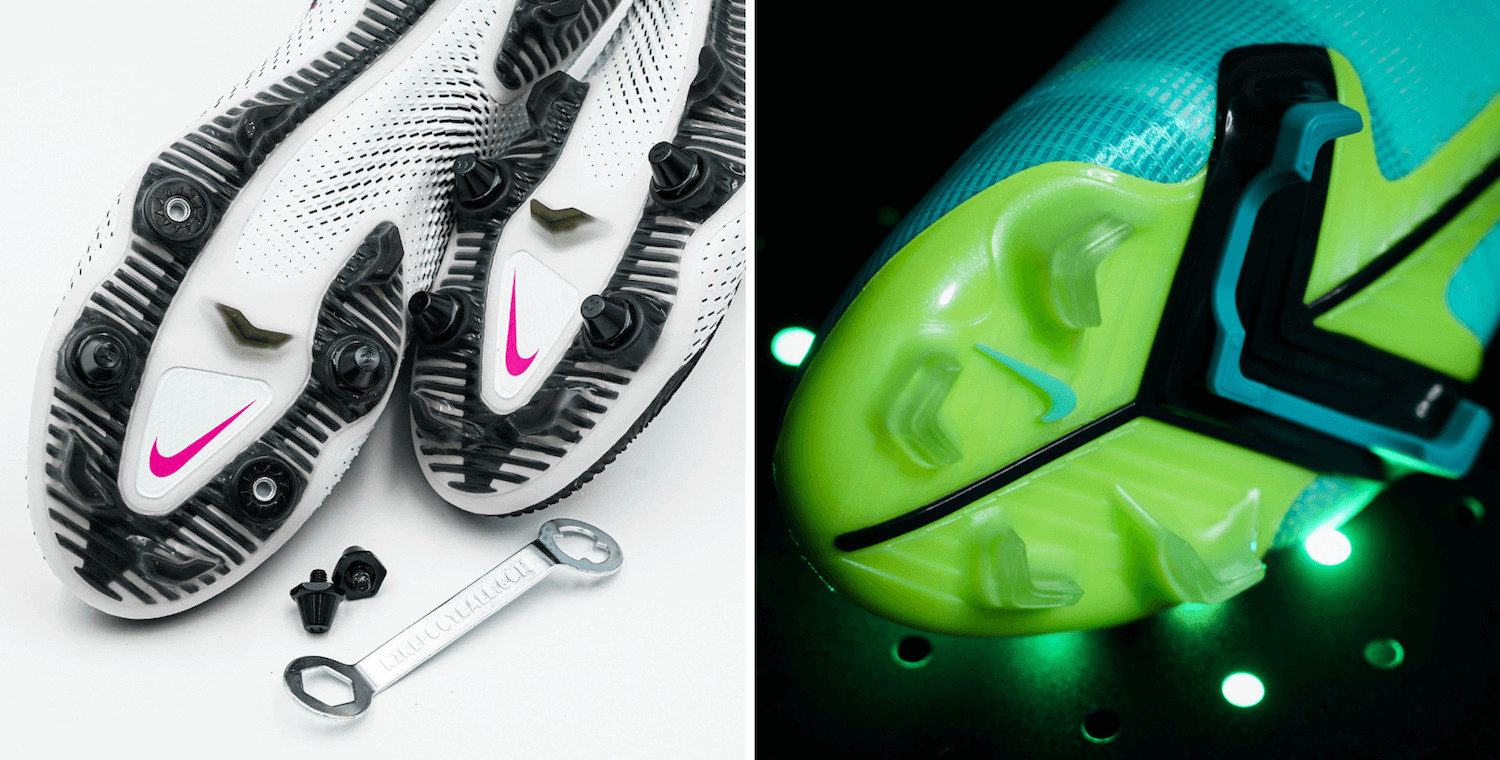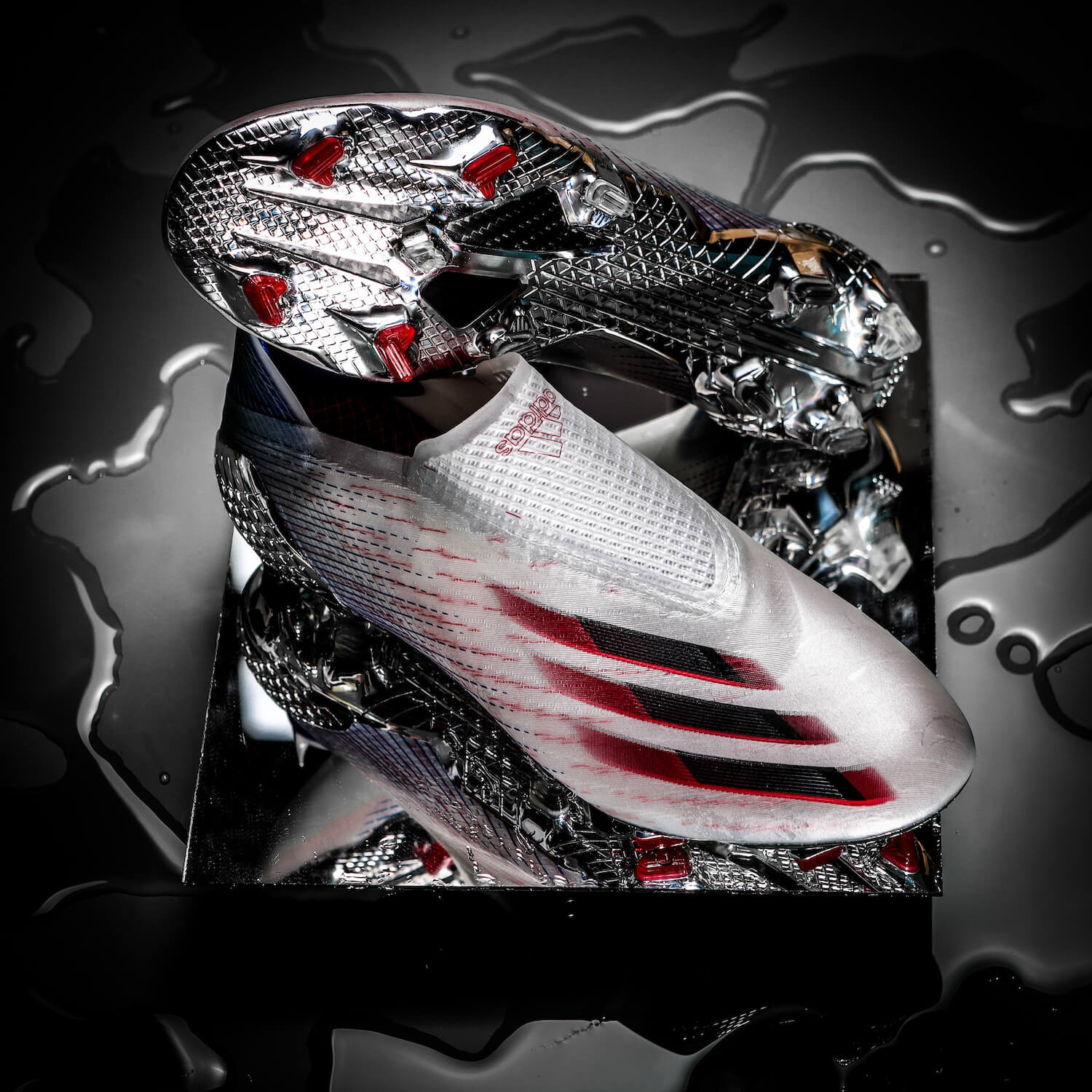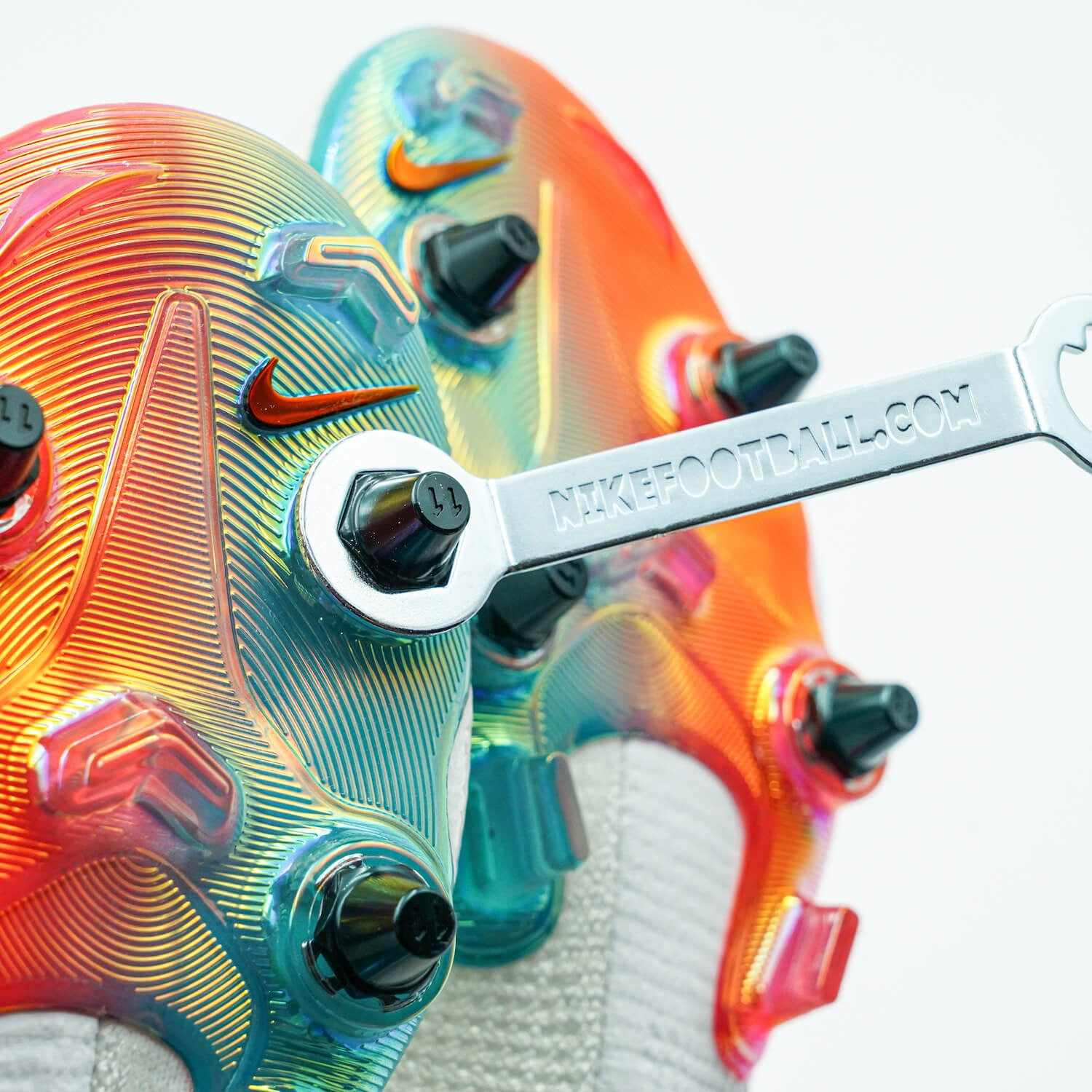Are you confused about “SG” when shopping for football boots? This guide clarifies what SG (Soft Ground) means in football boots, helping you choose the right footwear for optimal performance and safety on the field. Learn the key differences between SG and FG (Firm Ground) boots to dominate your next game!
Are you struggling to understand the different types of football boots and which ones are best for your playing surface? CAUHOI2025.UK.COM provides clear, reliable information to help you make the right choice. Discover the advantages of SG boots and find the perfect fit for your game.
1. Understanding “SG” in Football Boots: What Does It Mean?
SG in football boots stands for Soft Ground. These boots are specifically designed for wet, muddy, and soft grass surfaces. The key feature of SG boots is their longer studs, typically made of metal, which provide superior grip and traction in slippery conditions. These studs dig deeper into the ground, preventing you from slipping and helping you maintain your balance and agility.
1.1 Why Soft Ground Boots Matter
Playing on soft ground with the wrong type of boots can significantly hinder your performance and increase the risk of injury. SG boots provide the necessary stability and grip, allowing you to make quick turns, accelerate effectively, and maintain control in challenging conditions. According to a study by the American Academy of Sports Medicine, proper footwear can reduce the incidence of ankle sprains and other lower extremity injuries by up to 30%.
1.2 Key Features of Soft Ground Boots
- Longer Studs: Usually metal, providing deep penetration into soft ground.
- Stud Configuration: Often features a 6-stud configuration (4 at the front, 2 at the back) or a mix of studs for enhanced grip.
- Interchangeable Studs: Many SG boots have studs that can be changed to adjust to varying ground conditions.
- Durable Construction: Designed to withstand the rigors of playing on wet and muddy surfaces.
2. Firm Ground (FG) vs. Soft Ground (SG) Boots: Key Differences
Understanding the differences between FG and SG boots is crucial for selecting the right footwear. Here’s a breakdown:
| Feature | Firm Ground (FG) Boots | Soft Ground (SG) Boots |
|---|---|---|
| Surface | Dry, natural grass with short blades. | Wet, muddy, and soft natural grass. |
| Stud Length | Shorter, typically made of hard plastic or rubber. | Longer, often metal, designed to penetrate soft ground. |
| Stud Type | Molded, non-interchangeable. | Interchangeable studs are common. |
| Traction | Designed for grip on firm, dry surfaces. | Provides maximum grip and stability on soft, muddy surfaces. |
| Injury Risk | Less suitable for wet conditions, increasing the risk of slipping. | Ideal for wet conditions, reducing the risk of slipping and improving stability. |
| Typical Usage | Parks, natural fields. | Professional fields, private pitches, and fields in wetter environments. |
2.1 When to Choose FG Boots
FG boots are designed for use on firm, natural grass surfaces. They feature shorter, molded studs that provide adequate grip on dry fields. These boots are ideal for most recreational games and training sessions in the USA, where fields are generally well-maintained and drier.
2.2 When to Choose SG Boots
SG boots are essential for playing on soft, muddy fields. The longer studs provide the necessary grip to prevent slipping and maintain control. If you frequently play in wet or humid climates, or on fields that are not well-drained, SG boots are the better choice.
 Soft Ground vs Firm Ground Football Boots
Soft Ground vs Firm Ground Football Boots
3. How to Identify the Playing Surface
Before choosing your football boots, it’s important to accurately assess the playing surface. Here are some tips:
3.1 Visual Inspection
- Firm Ground: The grass will be short, dry, and relatively hard. The surface should feel firm underfoot.
- Soft Ground: The grass will appear wetter and may have visible mud. The surface will feel soft and spongy underfoot.
3.2 Test the Ground
- Press your foot into the ground. If it leaves a deep impression, it’s likely soft ground.
- Check for standing water or excessive moisture on the surface.
3.3 Ask the Groundskeeper
If you’re unsure, ask the groundskeeper or field manager about the condition of the surface. They can provide valuable insights and help you make the right decision.
4. The Importance of Proper Traction and Grip
Proper traction and grip are essential for maximizing your performance and minimizing the risk of injury on the football field.
4.1 Enhancing Performance
- Improved Speed and Agility: With the right grip, you can accelerate quickly, make sharp turns, and maintain your speed without slipping.
- Better Ball Control: Stable footing allows you to focus on controlling the ball and making accurate passes.
- Increased Confidence: Knowing you have the right grip can boost your confidence and allow you to play more aggressively.
4.2 Preventing Injuries
- Reduced Risk of Ankle Sprains: Proper grip prevents your foot from twisting or slipping, reducing the risk of ankle sprains.
- Minimized Knee Injuries: Stable footing helps maintain proper alignment and reduces stress on your knees.
- Prevention of Falls: Adequate traction prevents falls, especially in wet conditions, reducing the risk of serious injuries. A study published in the American Journal of Sports Medicine found that athletes wearing appropriate footwear experienced a 40% reduction in lower extremity injuries.
5. Top Brands and Models for Soft Ground Football Boots
Several leading brands offer high-quality SG boots designed for optimal performance. Here are some top choices:
5.1 Adidas
Adidas is known for its innovative designs and high-performance materials. Their SG boots often feature advanced stud configurations and durable construction. Popular models include the Adidas Predator and Adidas X series.
 Soft Ground vs Firm Ground Football Boots
Soft Ground vs Firm Ground Football Boots
5.2 Nike
Nike is another leading brand in the football boot market. Their SG boots are designed for maximum grip and comfort, with features like Flyknit uppers and innovative stud patterns. Popular models include the Nike Mercurial and Nike Tiempo series.
 Soft Ground vs Firm Ground Football Boots
Soft Ground vs Firm Ground Football Boots
5.3 Puma
Puma offers a range of SG boots that combine style and performance. Their boots often feature lightweight materials and unique stud designs. Popular models include the Puma Future and Puma King series.
6. Caring for Your Soft Ground Football Boots
Proper care is essential for extending the life of your SG boots and maintaining their performance.
6.1 Cleaning After Each Use
- Remove any dirt or mud with a soft brush or cloth.
- Wash the boots with mild soap and water.
- Avoid using harsh chemicals or abrasive cleaners.
6.2 Drying Properly
- Allow the boots to air dry in a well-ventilated area.
- Avoid placing them near direct heat or sunlight, which can damage the materials.
- Stuff the boots with newspaper to help absorb moisture and maintain their shape.
6.3 Storing Correctly
- Store the boots in a cool, dry place.
- Use a boot bag to protect them from dust and scratches.
- Consider using shoe trees to maintain their shape.
7. The Role of Stud Configuration in SG Boots
The arrangement and design of studs on SG boots play a crucial role in providing optimal grip and stability.
7.1 Traditional 6-Stud Configuration
The classic SG boot design features 6 studs: 4 at the front and 2 at the back. This configuration provides excellent grip for straight-line speed and stability during turns.
7.2 Mixed Stud Configurations
Many modern SG boots incorporate a mix of stud types and lengths to enhance traction and agility. These designs may include a combination of bladed and conical studs, or longer studs at the edges for improved grip during lateral movements.
7.3 Interchangeable Studs
The ability to change studs allows you to customize your boots for different ground conditions. Longer studs provide maximum grip in very soft conditions, while shorter studs can be used on slightly firmer surfaces.
8. The Impact of Climate and Field Conditions on Boot Choice
The local climate and field conditions significantly influence the type of football boots you should choose.
8.1 Humid Climates
In regions with high humidity and frequent rainfall, such as the southeastern United States, SG boots are often the best choice. The wet conditions make the ground soft and muddy, requiring the superior grip of SG studs.
8.2 Arid Climates
In drier regions, such as the southwestern United States, FG boots are generally more suitable. The fields are typically firmer and less prone to becoming muddy.
8.3 Seasonal Changes
Even in regions with moderate climates, seasonal changes can affect field conditions. During the rainy season, SG boots may be necessary, while FG boots are ideal for the drier months.
9. Multi-Ground (MG) Boots: Are They a Good Alternative?
Multi-ground (MG) boots are designed for use on artificial turf surfaces. While they offer versatility, they are not a substitute for either FG or SG boots.
9.1 Understanding MG Boots
MG boots feature a soleplate with numerous short studs that provide grip on artificial grass. They are designed to distribute weight evenly and provide comfort during play.
9.2 Limitations of MG Boots
MG boots do not provide sufficient grip on natural grass, especially in wet or muddy conditions. Using them on soft ground can lead to slipping and increase the risk of injury.
9.3 Best Use Cases for MG Boots
MG boots are ideal for training sessions and games played on artificial turf fields. They offer a good balance of grip and comfort for this type of surface.
10. Finding the Right Fit for Your Soft Ground Boots
Proper fit is crucial for comfort and performance. Here are some tips for finding the right size:
10.1 Measuring Your Feet
Measure your feet in the evening, as they tend to swell throughout the day. Wear the socks you typically wear for football. Use a ruler or measuring tape to determine the length and width of your feet.
10.2 Trying on Boots
When trying on boots, make sure there is about a thumb’s width of space between your longest toe and the end of the boot. The boots should feel snug but not too tight. Walk around and perform some basic movements to ensure they are comfortable and provide adequate support.
10.3 Considering Width
If you have wide feet, look for boots that are specifically designed for wider feet. Some brands offer models in different widths to accommodate various foot shapes.
FAQ: Answering Your Questions About SG Football Boots
Q1: Can I use FG boots on soft ground?
No, FG boots do not provide enough grip on soft ground and can lead to slipping and injury.
Q2: How often should I replace my SG boots?
It depends on how frequently you play and the condition of the boots. Replace them when the studs become worn or damaged, or when the upper shows signs of wear.
Q3: Are metal studs dangerous?
Metal studs are safe when used on the appropriate surface. However, they should not be worn on hard or artificial surfaces, as they can cause injury to yourself and others.
Q4: Can I change the studs on my SG boots myself?
Yes, most SG boots have interchangeable studs that can be easily changed with a stud wrench.
Q5: How do I prevent my SG boots from smelling?
Air them out after each use and consider using a boot dryer or odor-absorbing insoles.
Q6: What is the difference between SG-Pro and regular SG boots?
SG-Pro boots are designed for professional players and often feature higher-quality materials and advanced technologies.
Q7: Are SG boots suitable for all weather conditions?
SG boots are best for wet and muddy conditions. In extremely cold weather, the ground may freeze, making FG boots more suitable.
Q8: How do I clean the studs on my SG boots?
Use a wire brush to remove dirt and mud from the studs. You can also soak them in warm, soapy water.
Q9: Can I wear SG boots on artificial turf?
No, SG boots are not designed for artificial turf and can damage the surface. Use MG boots instead.
Q10: Where can I buy SG football boots?
You can find SG football boots at most sporting goods stores or online retailers. Check out CAUHOI2025.UK.COM for recommendations and deals.
Conclusion: Choosing the Right Boots for Optimal Performance
Selecting the right football boots is essential for maximizing your performance and minimizing the risk of injury. Understanding the differences between FG and SG boots, assessing the playing surface, and considering the climate and field conditions are all important factors. By following the tips and guidelines in this guide, you can choose the perfect pair of boots and dominate your next game!
Are you still unsure which football boots are right for you? Visit CauHoi2025.UK.COM for more information and expert advice. Our team of experienced professionals can help you find the perfect fit and answer any questions you may have. Contact us today at +1 (800) 555-0199 or visit our office at Equitable Life Building, 120 Broadway, New York, NY 10004, USA. We are here to help you succeed on the field!

